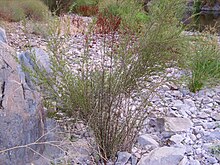
Pimelea microcephala, commonly known as mallee rice-flower or shrubby rice-flower is a species of flowering plant in the family Thymelaeaceae and is endemic to mainland Australia. It is an erect shrub with compact heads of male or female, white to yellow or greenish flowers on separate plants, the heads surrounded by 2 or 4 leaf-like involucral bracts.
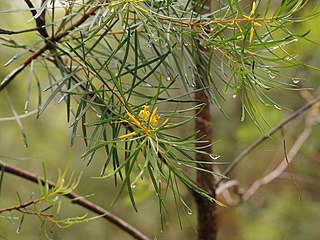
Persoonia virgata is a species of flowering plant in the family Proteaceae and is endemic to coastal areas of eastern Australia. It is usually an erect shrub with smooth bark, hairy young branchlets, linear to narrow spatula-shaped leaves, and yellow flowers borne in groups of up to seventy-five on a rachis up to 230 mm (9.1 in) long that continues to grow after flowering.

Persoonia brevifolia is a plant in the family Proteaceae and is endemic to a restricted area near the border between south-eastern New South Wales and Victoria. It is an erect shrub with elliptic to egg-shaped leaves and cylindrical yellow flowers arranged singly in leaf axils.
Persoonia tropica is a plant in the family Proteaceae and is endemic to north Queensland. It is an erect shrub to small tree shrub with branchlets that are hairy when young, narrow elliptic to lance-shaped leaves and yellow flowers in groups of three to ten on a rachis 3–10 mm (0.12–0.39 in) long that continues to grow after flowering.
Persoonia baeckeoides is a species of flowering plant in the family Proteaceae and is endemic to Western Australia. It is an erect, spreading, many-branched shrub with smooth bark, spatula-shaped leaves and greenish yellow flowers arranged singly or in groups of up to three.

Zanthoxylum rhetsa, commonly known as Indian prickly ash, is a species of flowering plant in the family Rutaceae and occurs from India east to the Philippines and south to northern Australia. It is a deciduous shrub or tree with cone-shaped spines on the stems, pinnate leaves with between nine and twenty-three leaflets, panicles of white or yellowish, male and female flowers, followed by spherical red, brown or black follicles.

Chaenorhinum origanifolium is a species of flowering plant in the family Plantaginaceae. It is native to mountainous regions of the Iberian Peninsula and the Balearic Islands. It grows on rocks and crevices of escarpments, usually in limestone cliffs.

Pultenaea glabra, commonly known as smooth bush-pea, is a species of flowering plant in the family Fabaceae and is endemic to eastern New South Wales. It is an erect shrub with glabrous stems, linear to egg-shaped leaves with a concave upper surface, and yellow to red and orange flowers.
Daviesia eremaea is a species of flowering plant in the family Fabaceae and is endemic to central Australia. It is an erect, glabrous, multi-stemmed shrub with needle-like, more or less sharply-pointed phyllodes, and yellow and red flowers.

Pimelea tinctoria is a species of flowering plant in the family Thymelaeaceae and is endemic to the south-west of Western Australia. It is an erect, spindly shrub with elliptic leaves arranged in opposite pairs, and compact heads of many yellow or yellowish-green flowers usually surrounded by 4 to 7 pairs of egg-shaped to narrowly elliptic yellow and green involucral bracts.
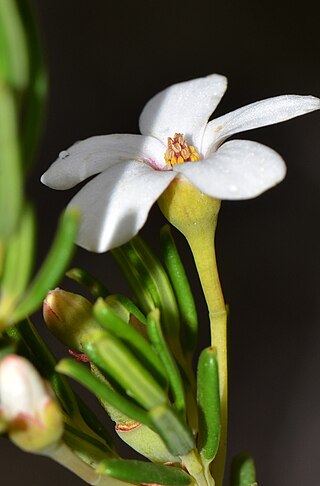
Ricinocarpos cyanescens is a species of flowering plant in the family Euphorbiaceae and is endemic to the south-west of Western Australia. It is a compact, monoecious shrub with narrowly oblong leaves and male and female flowers arranged singly or in small groups.
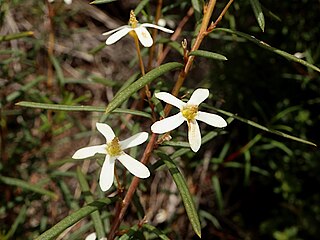
Ricinocarpos glaucus is a species of flowering plant in the family Euphorbiaceae and is endemic to the south-west of Western Australia. It is an erect, monoecious or dioecious shrub with linear or narrowly oblong leaves and male and female flowers arranged singly or in small groups.
Ricinocarpos graniticus is a species of flowering plant in the family Euphorbiaceae and is endemic to the southwest of Western Australia. It is a monoecious shrub with linear leaves and creamy white flowers, arranged either singly, or with a single female flower surrounded by one or two male flowers.
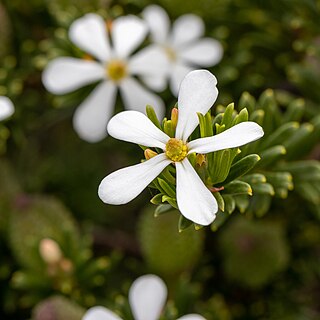
Ricinocarpos megalocarpus is a species of flowering plant in the family Euphorbiaceae and is endemic to the south coast of Western Australia. It is a compact, rounded, usually monoecious shrub with linear leaves and white flowers, arranged either singly, or male flowers in groups, or with a single female flower surrounded by up to six male flowers.
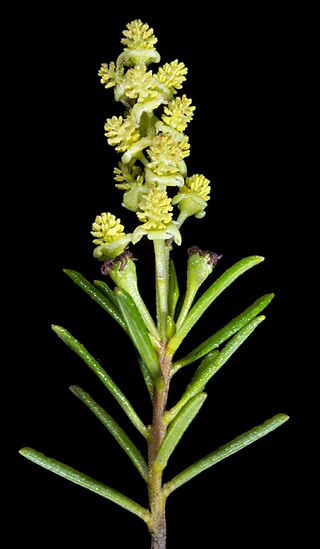
Ricinocarpos muricatus is a species of flowering plant in the family Euphorbiaceae and is endemic to the south-west of Western Australia. It is an erect to spreading, sticky, monoecious shrub with linear leaves and yellow flowers arranged in a raceme, with one or two female flowers surrounded by 8 to 12 male flowers.
Ricinocarpos oliganthus is a species of flowering plant in the family Euphorbiaceae and is endemic to a small area in the south-west of Western Australia. It is a monoecious shrub with linear to narrowly oblong leaves and white to creamy white flowers arranged singly on the ends of branchlets.
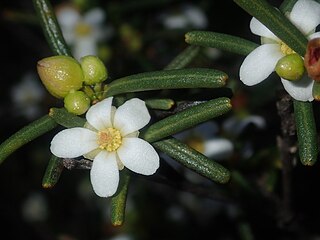
Ricinocarpos psilocladus is a species of flowering plant in the family Euphorbiaceae and is endemic to the west coast of Western Australia. It is an erect, open, monoecious or dioecious shrub with linear to narrowly oblong or narrowly egg-shaped leaves, and white or yellow flowers arranged singly, or with two to five male flowers, or a single female flower surrounded by up to three male flowers.
Ricinocarpos rosmarinifolius is a species of flowering plant in the family Euphorbiaceae and is endemic to the Kimberley of northern Western Australia. It is an erect, slender monoecious shrub with linear leaves and inconspicuous white flowers arranged singly, or with two to four male flowers, or a single female flower surrounded by up to four male flowers.
Ricinocarpos ruminatus is a species of flowering plant in the family Euphorbiaceae and is endemic to the Expedition Range in central Queensland. It is an erect, monoecious shrub with linear leaves and white flowers, arranged on the ends of branches with 2 to 5 male flowers, or a female flower surrounded by up to 4 male flowers.
Stachystemon vermicularis is a species of flowering plant in the family Picrodendraceae and is endemic to the southwest of Western Australia. It is a diffuse, monoecious shrub with linear leaves and small red male flowers and yellowish female flowers arranged singly in upper leaf axils, but forming clusters at the ends of branches.



